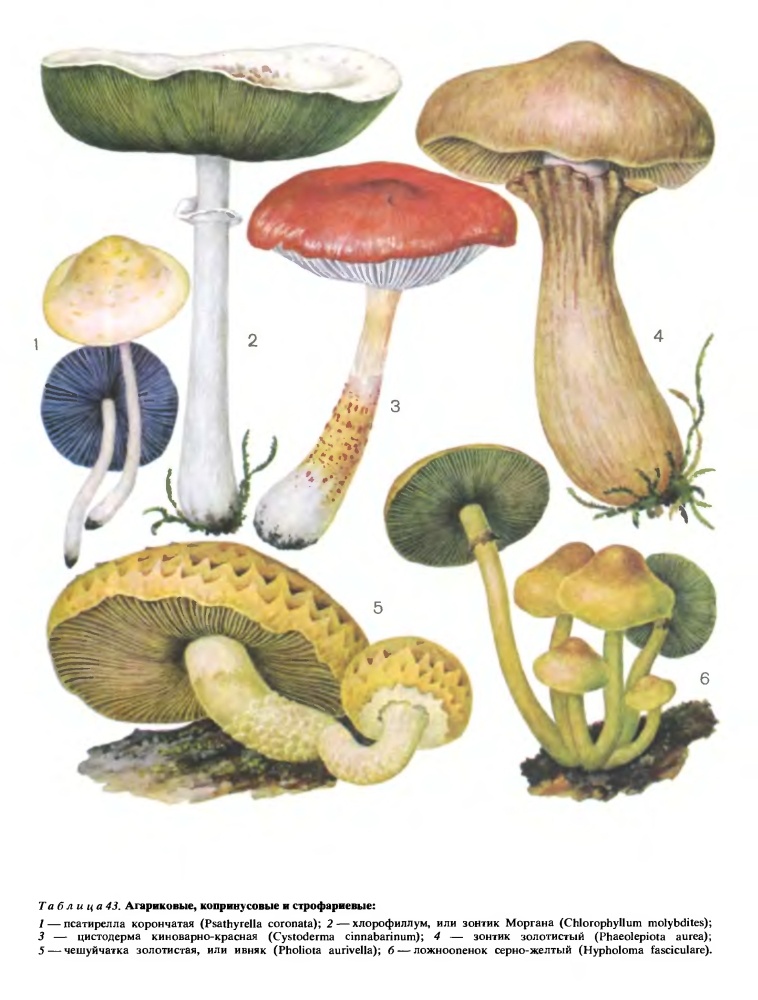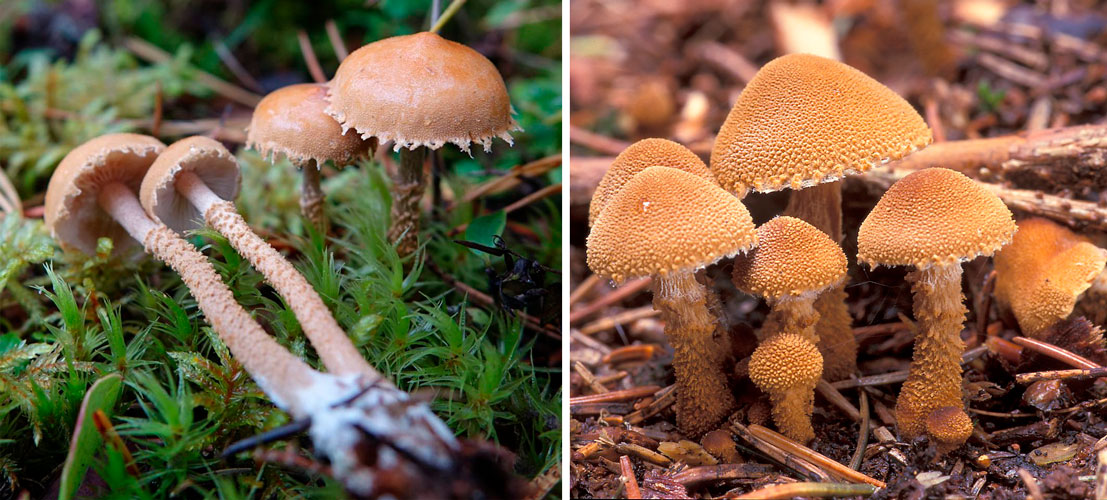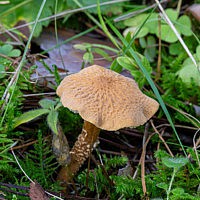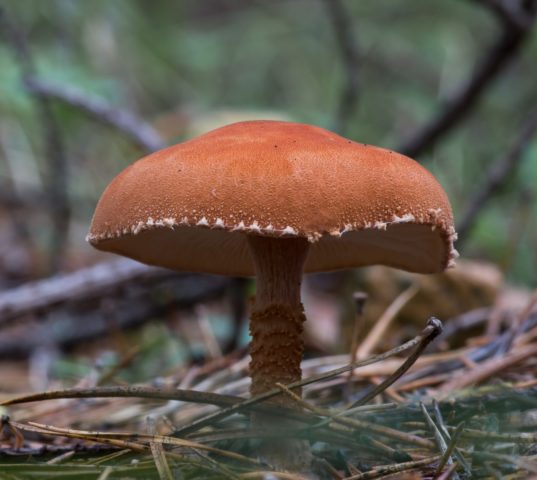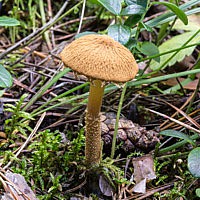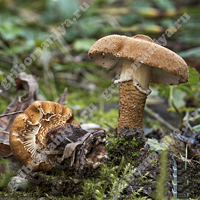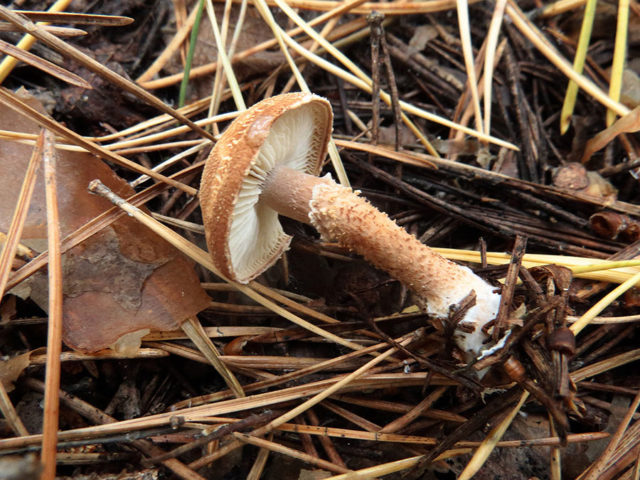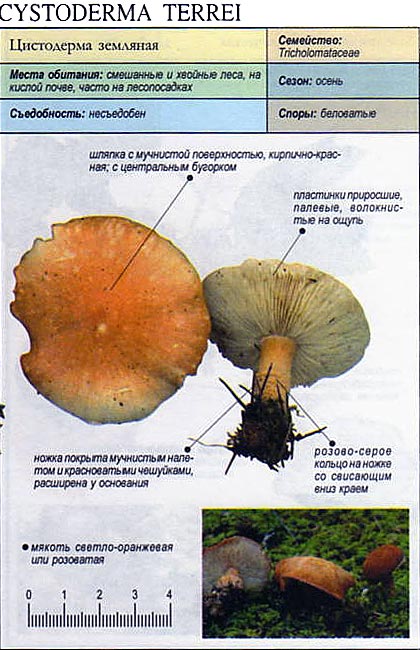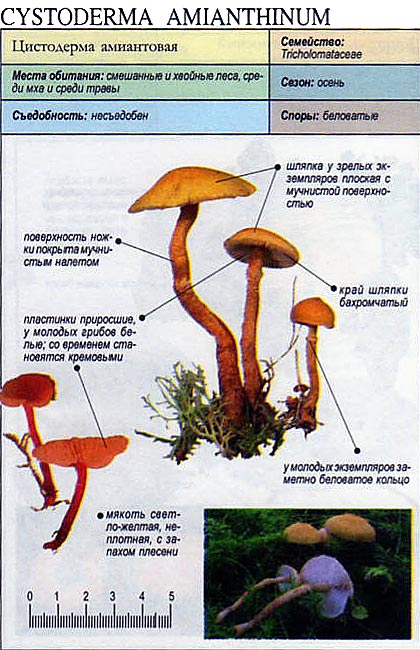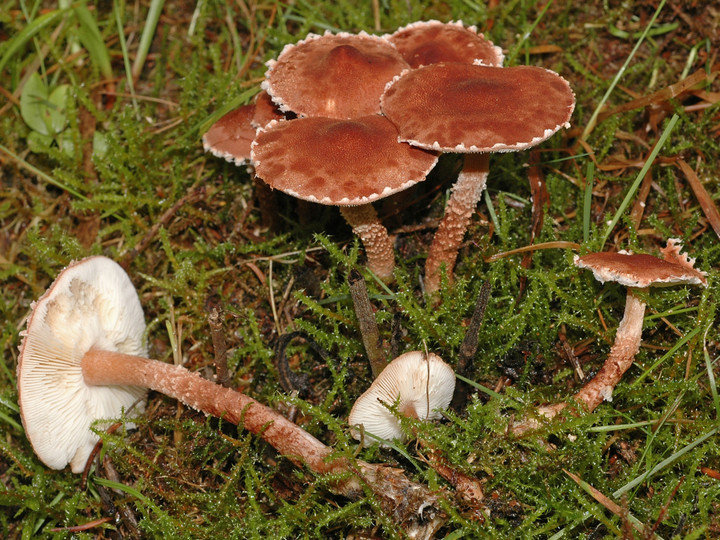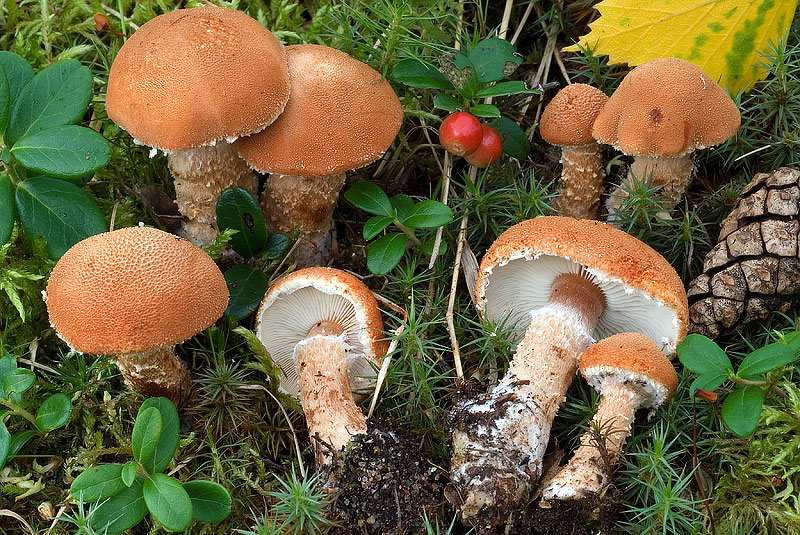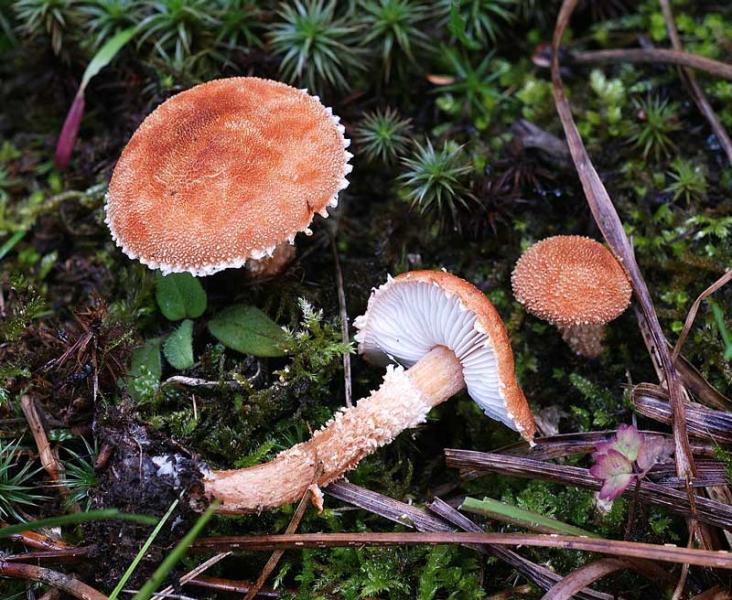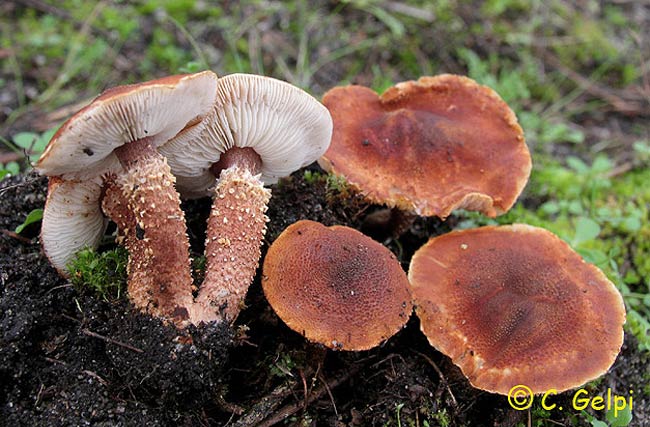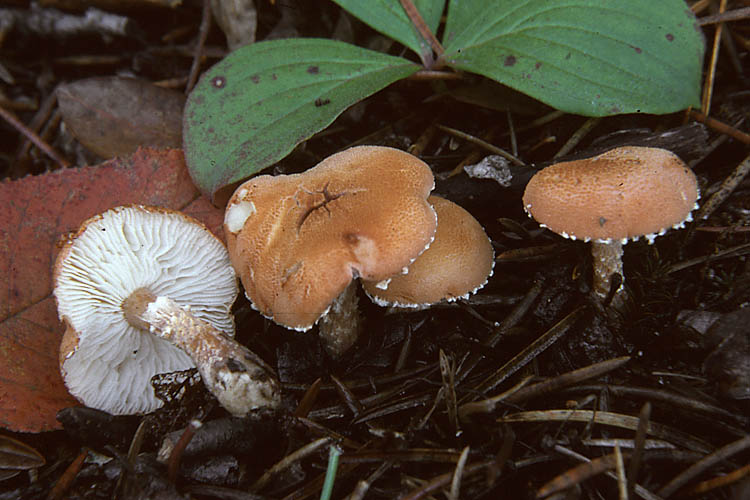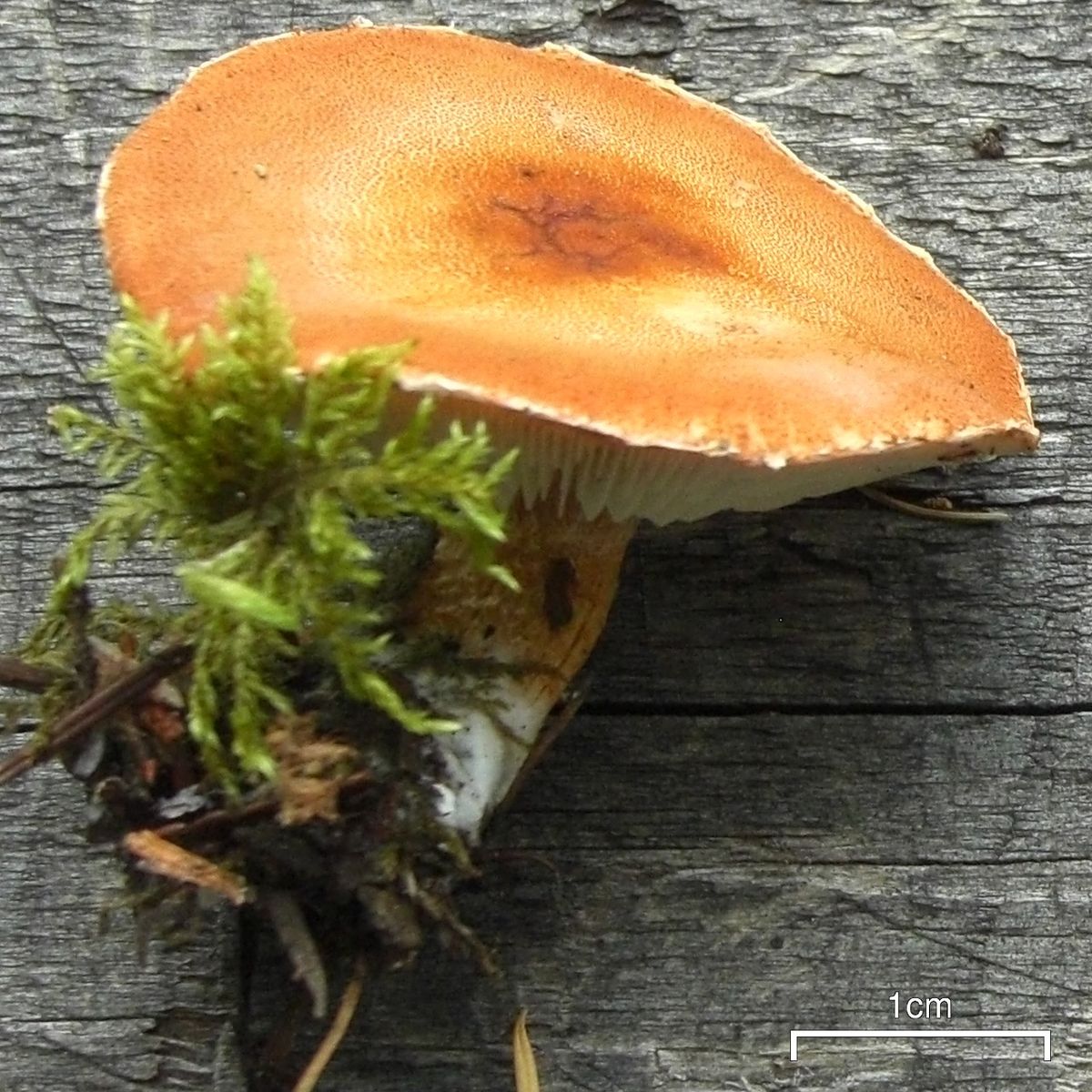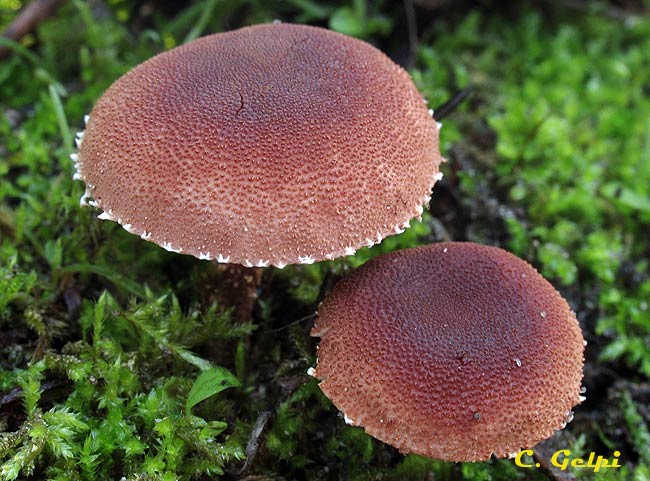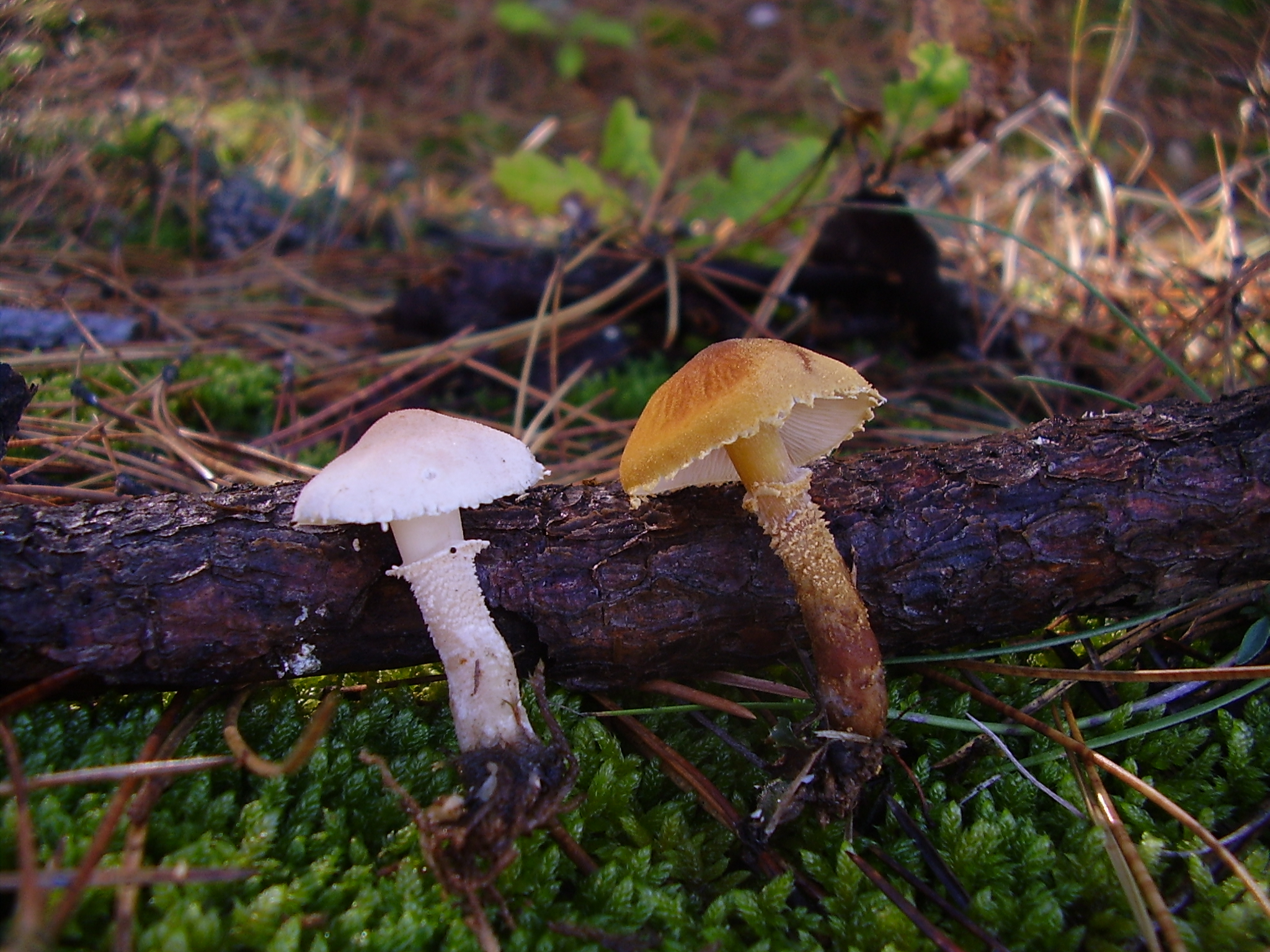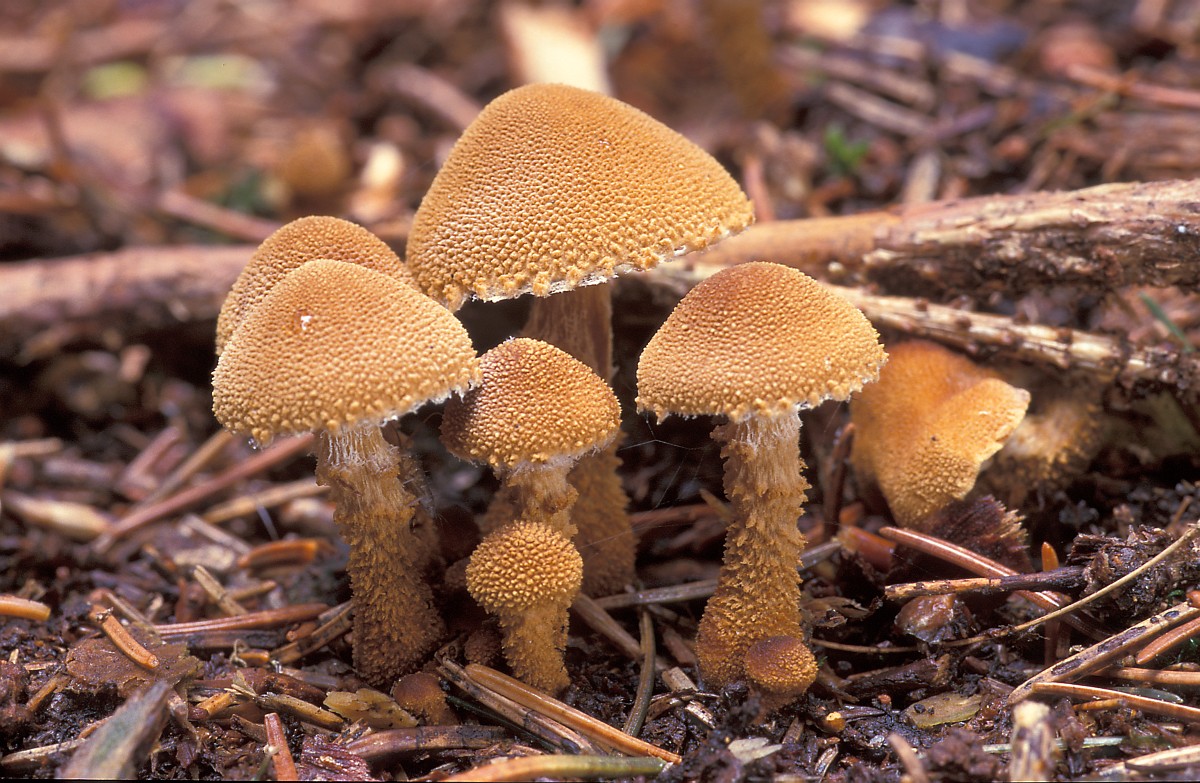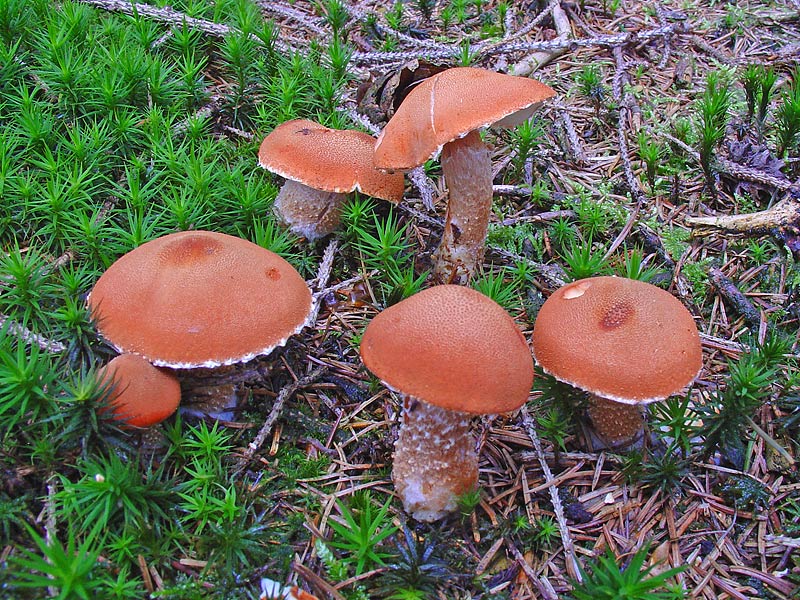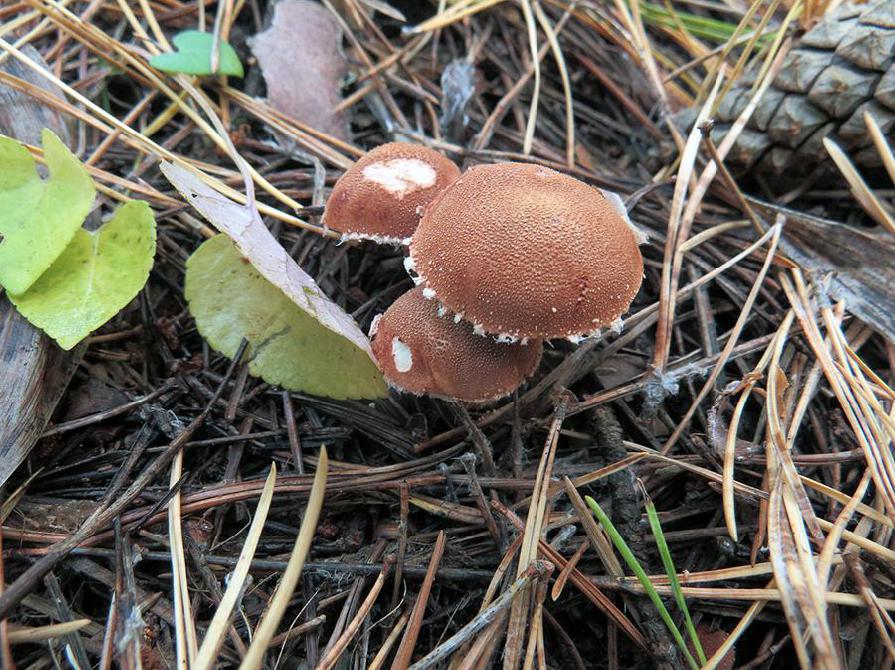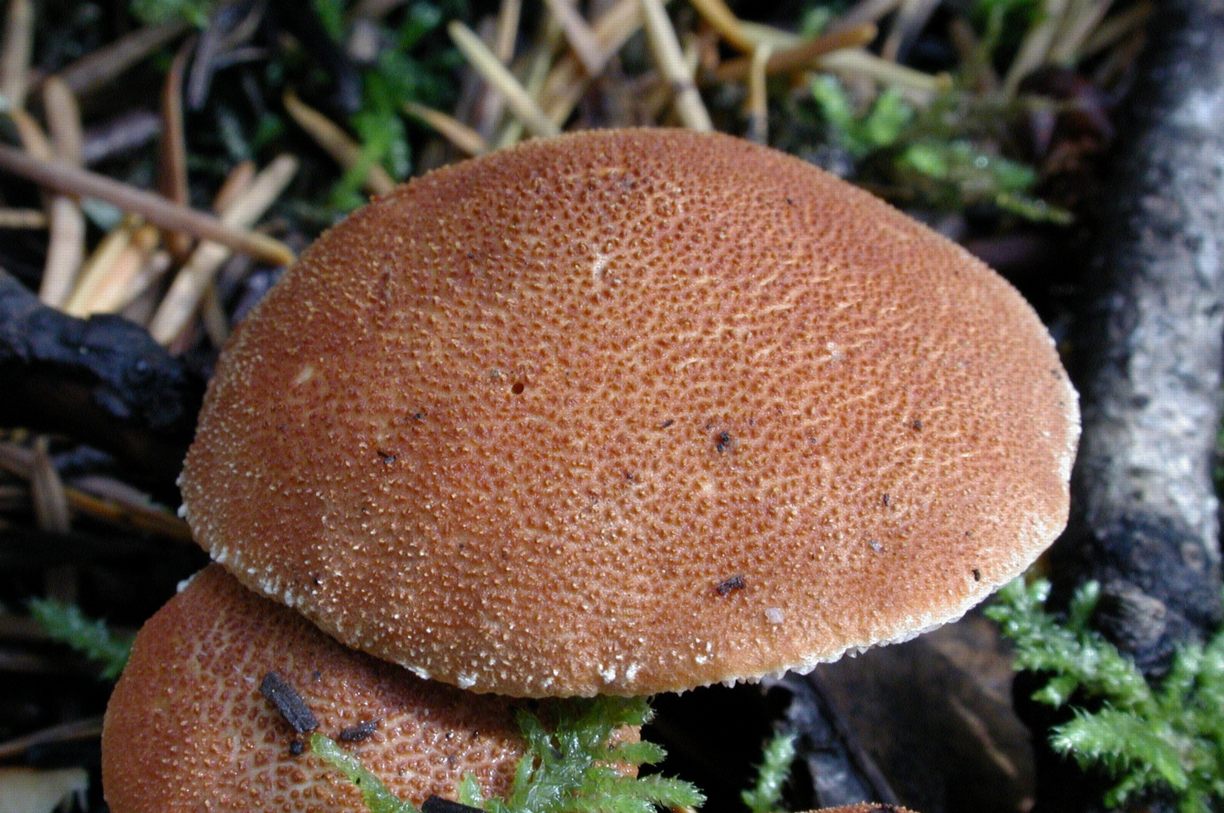Description
- The cap is semicircular or rounded-bell-shaped, later convex-outstretched, covered with the remains of a bedspread, mostly along the edge.
- The plates are white, milky-cream or slightly yellowish in color, with an even edge, adhered to the stem or weakly descending onto it, unequal.
- The pulp is non-amyloid.
- The stem is central, thin, covered with the remains of a blanket consisting of spherocysts; in its upper part there is a ring-shaped formation.
- The spore powder is whitish or pale cream. Spores are round, ellipsoidal, broadly or elongated-ellipsoidal, thin-walled, amyloid or non-amyloid, occasionally pseudoamyloid.
Ecology
- They grow on soil in forests or outside forests, in moss, sometimes on wood dust.
- Cosmopolitans are found on all continents, including Antarctica.
Scaly cystoderm (Scaly umbrella, Cystoderma carcharias) how mushrooms look, where and how
Scaly cystoderm (Scaly umbrella): photo and description
| Name: | Scaly cystoderm |
| Latin name: | Cystoderma carcharias |
| View: | Conditionally edible |
| Synonyms: | Odorous cystoderm, Scaly umbrella, Shark cystoderm |
| Specifications: |
|
| Systematics: |
|
Scaly cystoderm is a lamellar edible mushroom from the Champignon family. Due to its similarity with toadstools, virtually no one collects it. But it is advisable to know this rare mushroom, and if there are few others, then such a specimen can be replenished with a basket.
How does the scaly cystoderm look
Odorous cystoderm or scaly umbrella (these are other names for the mushroom) has a light pulp with a weak taste of wood. Consists of a cap and a leg. On the back of the cap, permanent plates of cream or light brown color are noticeable. Propagated by white spores.
Description of the hat
The development of the scaly cystoderm cap is as follows: conical (hemispherical) in youth, it becomes curved outward with a middle tubercle in adulthood with a diameter of up to 6 cm.The color is yellowish or gray-pink, but fades to white over the years. Dry surface on a matte base covered with white fine-grained powder of maturing spores. A fringe in the form of hanging flakes is visible at the edges of the cap.
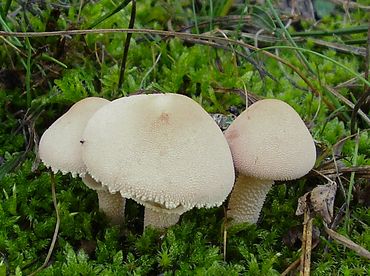
Leg description
The hollow in the middle of the leg of the scaly cystoderm has a height of 3-5 cm and a diameter of up to 5 mm. It is divided into two halves by a ring with a lapel: the upper one is light and smooth, the lower one is pimply.
Eat a mushroom or not
Does not have high-quality gustatory parameters. In terms of nutritional value, it belongs to the 4th category. It can be used for making soups and other gastronomic dishes. It is recommended to boil for at least 15 minutes. The broth is drained.
Where and how it grows
Cystoderm grows on the ground in moss or on fallen leaves and needles in mixed pine and coniferous forests. Prefers chalky soils. Distributed mainly in North America, Central Asia, Europe. In our country, it is a rare mushroom. There are single specimens and group shoots. The growing period is the second part of August and until November.
Doubles and their differences
There are several variants of this family:
- Cystoderm amianthus. Conditionally edible. It stands out with a more brown color, watery pulp. The leg has no ring.
- The cystoderm is red. It stands out with a reddish or orange tint, a larger cap and a thick leg. Has a mushroom aroma. Edible. You need to boil it.
Conclusion
The scaly cystoderm is an exotic mushroom. Therefore, it is better for novice mushroom pickers not to take the risk of collecting them.Only an experienced lover of quiet hunting can be sure that he has taken a “good” specimen.
An excerpt characterizing Cystoderm odorous
- Go, Balaga has arrived. Anatole got up and entered the dining room. Balaga was a well-known troika driver, who had known Dolokhov and Anatol for six years, and served them with his troikas. More than once, when Anatol's regiment was in Tver, in the evening he took him away from Tver, brought him to Moscow by dawn and took him away the next day at night. More than once he took Dolokhov away from the chase, more than once he rolled them around the city with gypsies and ladies, as Balaga called. More than once, with their work, he pressed the people and cabs around Moscow, and his gentlemen, as he called them, always rescued him. He drove more than one horse under them. More than once he was beaten by them, more than once they got him drunk with champagne and Madeira, which he loved, and he knew more than one thing behind each of them that an ordinary person would long ago deserve Siberia. In their carousing, they often invited Balaga, forced him to drink and dance with the gypsies, and not one thousand of their money passed through his hands. Serving them, he risked his life and his skin twenty times a year, and at their work he killed more horses than they overpaid him. But he loved them, loved this crazy ride, eighteen miles an hour, loved to roll over a cab and crush a pedestrian in Moscow, and fly at full speed through Moscow streets. He loved to hear this wild cry of drunken voices behind him: “Go! go! " whereas it was already impossible to go faster anyway; he loved to stretch the painful neck of a peasant who was neither alive nor dead, kept away from him. "Real gentlemen!" he thought. Anatol and Dolokhov also loved Balaga for his driving skill and for the fact that he loved what they did. Balaga dressed up with others, took twenty-five rubles for a two-hour ride, and only occasionally went with others, and sent more of his fellows. But with his masters, as he called them, he always rode himself and never demanded anything for his work. Only having learned through the valets the time when there was money, he came every few months in the morning, sober and, bowing low, asked to help him out. Gentlemen always put him in prison. “You’ll challenge me, Father Fyodor Ivanovich or your Excellency,” he said. “I’ve been disheartened at all, so you can lend what you can to go to the market. Both Anatol and Dolokhov, when they were in the money, gave him a thousand and two rubles each. Balaga was fair-haired, with a red face and especially a red, thick neck, a stocky, snub-nosed man, twenty-seven years old, with shiny small eyes and a small beard. He was dressed in a thin blue caftan with a silk lining, wearing a sheepskin coat. He crossed himself at the front corner and went up to Dolokhov, holding out a small black hand. - Fyodor Ivanovich! He said, bowing. - Great, brother. - Well, here he is. “Hello, your Excellency,” he said to Anatol who was entering, and he also held out his hand. - I tell you, Balaga, - Anatole said, putting his hands on his shoulders, - do you love me or not? A? Now do the service ... Which one did you come to? A? - As the ambassador ordered, on your animals, - said Balaga. - Well, do you hear, Balaga! Cut all three, and to arrive at three o'clock. A? - How are you going to go on what? - said Balaga, winking. - Well, I'll break your face, don't joke! - suddenly, rolling his eyes, shouted Anatole. - Why joke, - the coachman said with a laugh. - Will I regret it for my masters? That the horses will gallop urine, then we will go. - A! - said Anatole. - Well, sit down. - Well, sit down! - said Dolokhov. - Wait, Fyodor Ivanovich. - Sit down, you're lying, drink, - said Anatole and poured him a large glass of Madeira. The driver's eyes shone on the wine. Refusing for decency, he drank and wiped himself off with a red silk handkerchief in his hat. - Well, when to go then, Your Excellency? - Why ... (Anatole looked at his watch) now and go. Look, Balaga. A? Are you in time? - But how is the departure - will he be happy, otherwise why not keep up? - said Balaga. - Delivered to Tver, at seven o'clock kept up. I suppose you remember, Your Excellency.
What does the scaly cystoderm look like?
Fragrant cystoderm or scaly umbrella (these are other names for the mushroom) has a light pulp with a faint taste of wood. Consists of a cap and a leg. On the back of the cap, frequent plates of a cream or light brown color are visible. Propagated by white spores.
Description of the hat
The evolution of the scaly cystoderm cap is as follows: cone-shaped (hemispherical) in youth, it becomes curved outward with a middle tubercle in adulthood with a diameter of up to 6 cm.The color is yellowish or gray-pink, but eventually fades to white. The dry, matte surface is covered with a white, fine-grained powder of ripening spores. A fringe in the form of hanging flakes is visible at the edges of the cap.
Leg description
The leg of the scaly cystoderm, hollow inside, has a height of 3-5 cm and a diameter of up to 5 mm. It is divided into two halves by a ring with a lapel: the upper one is light and smooth, the lower one is pimply.
Notes (edit)
- According to the website Mycobank.org
- Vyacheslav Stepanov ... Cystoderma amianthinum. Mushrooms of the Kaluga region. Archived from the original on August 12, 2012. Retrieved June 20, 2011.
- Fayod, M.V ... Prodrome d'une histoire naturelle des Agaricinés //Annales des Sciences Naturelles, Botanique ... - Paris, 1889. - B. VII. - T. 9. - S. 350-351.
- ↑ 123Kuo, M ... Cystoderma amianthinum. Archived from the original on August 12, 2012. Retrieved June 20, 2011.
- ↑ 12Lesso, Thomas ... Mushrooms. - Moscow: AST, Astrel, 2007 .-- P. 97 .-- 304 p.
- Cystoderm amianthus. Mushrooms of the Leningrad Region. Archived from the original on August 12, 2012. Retrieved June 20, 2011.
- Cystoderm amianthus. Mushrooms of the middle lane. Archived from the original on August 12, 2012. Retrieved June 20, 2011.
Cystodermella granulosa
Cystodermella granulosa
Scientific name - Cystodermella granulosa (Batsch) Harmaja
Syn: Cystoderma granulosum
Description
The hat is 2.5-8 cm in diameter, dry, at first hemispherical with a tucked edge, evenly and densely covered with cone-shaped granules and warts, flat-convex at maturity, with a slightly uneven edge, from which the remnants of a common blanket often hang in the form of white flakes ; dark brown, cinnamon-brown, with age and in the sun fading to orange-brown, brick-red and even straw color.
The plates are adherent, frequent, slightly serrated, with plates, whitish or yellowish.
Leg - 2-9 cm long and up to 1 cm thick, dry, solid or hollow, cylindrical or expanding towards the base, one-color with a cap, with a rapidly disappearing flaky-scaly annular zone, covered with whitish to dark brown flakes below the annular zone and with a smooth, silky, slightly furrowed surface above it; often with white mycelial pubescence at the base.
The flesh is soft, whitish or creamy in the cap and brownish in the stem, with a mild taste and an indistinguishable faint odor.
Spore powder - white
Edible - the mushroom is edible, can be used similarly to Cystodermella cinnabarina, however, due to its small size and scarcity, collection for food purposes does not make much sense.
Habitat and distribution - on soil and among mosses in coniferous, mixed and deciduous forests, usually in small groups, in late summer and autumn. It can also grow on pastures, in gardens, on roadsides. It is widespread in North America and Europe (including the European part of Russia), it is also found in South America, North Africa and Asia (Siberia, the Far East, Japan, Korea, as well as Central and Southwest Asia).
Similar species
At a young or mature age and in a healthy, fresh state, the mushroom is easily identified by the cinnamon brown, without orange and red shades, the color of the cap and the same color of the leg without a ring. However, with age, the color can fade strongly, and the granules on the surface of the cap become invisible or completely disappear. In such cases, microscopy is necessary for accurate determination. The closest species, Cystodermella cinnabarina and Cystodermella adnatifolia, are very similar, but usually have bright red-orange caps and slightly lighter legs.Cystodermella ambrosii, which many mycologists consider only a variety of C. granulosum, is distinguished by snow-white fruit bodies, which, however, acquire a brownish-leathery color with age. Cystoderma amianthinum is predominantly yellow in color, ranging from straw to pale cinnamon. Cystoderma fallax can also be colored in light brown tones, but is well distinguished by a wide, showy and long-lasting ring. Cystoderma lilacipes, which has a similar brown cap, is distinguished by a purple or purple coloration of the upper part of the stem.
I. Krom and V. Kapitonov contributed to the creation of the description.
Doubles and their differences
There are several types of this family:
Cystoderm amianthus. Conditionally edible. It has a more brown color, watery pulp. The leg has no ring.
The cystoderm is red. It has a reddish or orange tint, a larger cap and a thick leg. Has a mushroom smell. Edible. It is necessary to boil
Important! Before collecting, you need to study the distinguishing features or upload a photo to your phone so as not to be confused with a poisonous mushroom.
- Death cap. Poisonous. Differences: a taller and thicker leg grows out of an egg-shaped white volva. The ring-skirt with fringe on the leg is directed downward.
Hebeloma sticky, false value
Hebeloma glue
Hebeloma crustuliniformes
Description. The hat is 4-15 cm in diameter, at first hemispherical, then convex or flat-spread, with an even flat edge, naked, yellowish-brown, sometimes darker in the center. Plates with a notch or adherent, yellowish-brown, in wet weather with drops of liquid, when dry, with spots in place of drops. Leg 3-12 × 0.8-2.5 cm, dense, hollow with age, whitish, turns yellow over time, slightly swollen at the base. The pulp is white at first, creamy over time, with a radish smell, bitterish.
Growth. Grows in deciduous and mixed forests.
Fruiting. Forms fruiting bodies in August - November.
Usage. Inedible mushroom.

